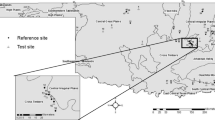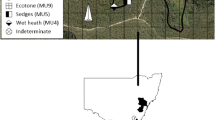Abstract
A method is presented for ecological assessment of botanical sample data from a nature reserve network. The approach uses regional floristic survey data for a specific biotope as a context for spatial and temporal comparison. Assessments are based upon floristic similarity to reference vegetation types and indicator scores that summarise multivariate plant species data in relation to important environmental gradients. The approach was implemented as a software tool using floristic survey data for soligenous mires in a UK region. Plant community monitoring data were assessed against reference communities from this regional baseline to illustrate the potential advantages of the method. These include; (a) allowing links to be made between multivariate plant species data and measurements of environmental drivers, (b) providing realistic assessments of spatial and temporal differences because comparisons are against typical values of indicator scores for the region, (c) providing the scope for setting realistic criteria for vegetation monitoring.
Similar content being viewed by others
References
Clapham AR, Tutin TG and Moore DM (1987) The Flora of the British Isles, 3rd edition. Cambridge University Press, Cambridge
Cooper E and Mackintosh J (1996) NVC review of Scottish grassland surveys. Scottish Natural Heritage Review no. 65. Scottish Natural Heritage, Edinburgh
Critchley CNR, Smart SM, Poulton SMC and Myers GM (1996) Monitoring the consequences of vegetation management in Environmentally Sensitive Areas. In: Vegetation Management in forestry, amenity and conservation areas. Aspects of Applied Biology 44: 193–201
Dayton PK, Tegner MJ, Edwards PB and Riser KL (1998) Sliding baselines, ghosts and reduced expectations in kelp forest communities. Ecol. Appl. 8: 309–322
Diekmann M (1995) Use and improvement of Ellenberg's indicator values in deciduous forests of the Boreo-nemoral zone in Sweden. Ecography 18: 178–189
Diekmann M and Dupre C (1997) Acidification and eutrophication of deciduous forests in northwestern Germany demonstrated by indicator species analysis. J. Veg. Sci. 8: 855–864
Ellenberg H, Weber HE, Dull R, Wirth V, Werner W and Paulissen D (1991) Zeigerwerte von Pflanzen in Mitteleuropa. Scripta Geobotanica 18: 1–248
Ertsen ACD, Alkemade JRM and Wassen MJ (1998) Calibrating Ellenberg indictaor values for moisture, acidity, nutrient availability and salinity in the Netherlands. Plant Ecology 135: 113–124
Fojt W and Harding M (1995) Thirty years of change in the vegetation communities of three valley mires in Suffolk, England. J. Appl. Ecol. 32: 561–577
Gibson CWD and Brown VK (1992) Grazing and vegetation change: deflected or modified succession. J. Appl. Ecol. 29: 120–131
Goslee SC, Brooks RP and Cole CA (1997) Plants as indicators of wetland water source. Plant Ecology 131: 199–206
Grime JP, Hodgson JG, Hunt R and Thompson K (1995) The Electronic Comparative Plant Ecology. Chapman & Hall, London
Grootjans AP, Schipper PC and Van der Windt HJ (1985) Influence of drainage on N-mineralisation and vegetation response in wet meadows. I. Calthion palustris stands. Acta Oecologia / Oecologia Plantarum 6: 403–417
Grootjans AP, Fresco LFM, de Leeuw CC and Schipper PC (1996)Degeneration of species-rich Calthion palustris hay meadows: some considerations on the community concept. J. Veg. Sci. 7: 185–194
Harding M (1993) Redgrave and Lopham fens, East Anglia, England: a case study of change in flora and fauna due to groundwater abstraction. Biol. Cons. 66: 35–45
Hill MO and Carey PD (1997) Prediction of yield in the Rothamsted Park Grass experiment by Ellenberg indicator values. J. Veg. Sci. 8: 574–579
Hill MO, Mountford JO, Roy DB and Bunce RGH (1999) Ellenberg's indicator values for British plants. ECOFACT Volume 2, Technical Annex. Department of the Environment, Transport and the Regions: ITE Monkswood, Huntingdon
Hill MO, Roy DB, Mountford JO and Bunce RGH (in press) Extending Ellenberg's indicator values to a new area: an algorithmic approach. J. Appl. Ecol.
Hodgson JG (1991) Management for the conservation of plants with particular reference to the British flora. In: Spellerberg IF, Goldsmith FB and Morris MG (eds) The Scientific Management of Temperate Communities for Conservation, pp 81–102, 31st Symposium of the British Ecological Society. Blackwell, Oxford
Jongman RHG, ter Braak CJF and van Tongeren OFR (1995) Data Analysis in Community and Landscape Ecology. Cambridge University Press, Cambridge
Keymer RJ and Fry G (1996) Monitoring change. In: Lawson TG and Reed TM (eds) Nature Reserves-Who Needs Them?, pp 78–82 Joint Nature Conservation Committee, Peterborough
Magurran AE (1988) Ecological Diversity and its Measurement. Chapman and Hall, London
McDonald AW(1993) The role of seedbank and sown seeds in the restoration of an English flood-meadow. J. Veg. Sci. 4: 395–400
Melman CP, Clausman PHMA and Udo de Haes HA (1988) The testing of three indicator systems for trophic state in grasslands. Vegetatio 75: 143–152
Mountford JO and Chapman JM (1993) Water regime requirements of British wetland vegetation: using the moisture classifications of Ellenberg and Londo. J. Env. Man. 38: 248–274
Mountford JO, Lakhani KH and Kirkham FW (1993) Experimental assessment of the effects of nitrogen addition under hay-cutting and aftermath grazing on the vegtetation of meadows on a Somerset peat moor. J. Appl. Ecol. 30: 321–332
Philippi TE, Dixon PM and Taylor BE (1998) Detecting trends in species composition. Ecol Appl. 8: 300–308
Pfadenhauer J and Klötzli F (1996) Restoration experiments in middle European wet terrestrial ecosytems: an overview. Vegetatio 126: 101–115
Radley GP (1994) Sand Dune Vegetation Survey of GB: a national inventory. Part 1: England. Joint Nature Conservation Committee, Peterborough
Rodwell JS (1991a) British Plant Communities. Vol 1. Woodland and Scrub. CUP
Rodwell JS (1991b) British Plant Communities. Vol 2. Mires and Heaths. CUP
Rodwell JS (1992) British Plant Communities. Vol 3. Grasslands and Montane Communities. CUP
Rodwell JS, Pignatti S, Mucina L and Schaminée JHJ (1993) European vegetation survey: update on progress. J. Veg. Sci. 6: 759–762
SAS Institute Inc. (1988) SAS/STAT User's Guide, Release 6.03 Edition, pp 405–420. SAS Institute, Cary, North Carolina
Smith AJE (1978) The Moss Flora of Britain and Ireland. Cambridge University Press, Cambridge
ter Braak CJF and Gremmen NJM (1987) Ecological amplitudes of plant species and the internal consistency of Ellenbergs' indicator values for moisture. Vegetatio 69: 79–87
ter Braak CJF and Looman CWN (1986) Weighted averaging, logistic regression and the Gaussian response model. Vegetatio 65: 3–11
Thimonier A, Dupouey JL, Bost F and Becker M (1994) Simultaneous eutrophication and acidification of a forest ecosystem in North-East France. New. Phytol. 126: 533–539
Thompson K, Hodgson JG, Grime JP, Rorison IH and Band SR (1993) Ellenberg numbers revisited. Phytocoenologia 23: 277–289
van der Maarel E (1993) Relations between sociological-ecological species groups and Ellenberg indicator values. Phytocoenologia 23: 343–362
Vyvey Q (1983) Study of the seed bank in Schoeno-juncetum subnodulosi All. 1922 and in Molinietum caerulae All. 1922. Acta Botanica Neerlandica 32: 246–247
Wheeler BD (1988) Species richness, species rarity and conservation evaluation of rich fen vegetation in lowland England and Wales. J. Appl. Ecol. 25: 331–353
Wheeler BD and Shaw SC (1987) Comparative survey of habitat conditions and management characteristics of herbaceous rich-fen vegetation types. Contract survey report no. 6. Nature Conservancy Council, Peterborough
Wheeler BD and Shaw SC (1992) Biological indicators of the dehydration and changes to East Anglian fens, past and present. English Nature Research Report No. 22. Environmental Consultancy, University of Sheffield
Yeo MJM, Blackstock TH and Stevens DP (1998) The use of phytosociological data in conservation assessment: a case study of lowland grasslands in mid Wales. Biol. Cons. 86: 125–138
Zar JH (1984) Biostatistical Analysis, 2nd edition, p 71. Prentice Hall, Englewood Cliffs, New Jersey
Author information
Authors and Affiliations
Rights and permissions
About this article
Cite this article
Smart, S.M. Ecological assessment of vegetation from a nature reserve using regional reference data and indicator scores. Biodiversity and Conservation 9, 811–832 (2000). https://doi.org/10.1023/A:1008948602316
Issue Date:
DOI: https://doi.org/10.1023/A:1008948602316




